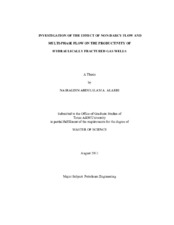| dc.contributor.advisor | Valko, Peter | |
| dc.creator | Alarbi, Nasraldin Abdulslam A. | |
| dc.date.accessioned | 2011-10-21T22:03:44Z | |
| dc.date.accessioned | 2011-10-22T07:11:50Z | |
| dc.date.available | 2011-10-21T22:03:44Z | |
| dc.date.available | 2011-10-22T07:11:50Z | |
| dc.date.created | 2011-08 | |
| dc.date.issued | 2011-10-21 | |
| dc.date.submitted | August 2011 | |
| dc.identifier.uri | https://hdl.handle.net/1969.1/ETD-TAMU-2011-08-9786 | |
| dc.description.abstract | Hydraulic fracturing has recently been the completion of choice for most tight gas bearing formations. It has proven successful to produce these formations in a commercial manner. However, some considerations have to be taken into account to design an optimum stimulation treatment that leads to the maximum possible productivity. These considerations include, but not limited to, non-Darcy flow and multiphase flow effects inside the fracture. These effects reduce the fracture conductivity significantly. Failing to account for that results in overestimating the deliverability of the well and, consequently, to designing a fracture treatment that is not optimum.
In this work a thorough investigation of non-Darcy flow and multi-phase flow effects on the productivity of hydraulically fractured wells is conducted and an optimum fracture design is proposed for a tight gas formation in south Texas using the Unified Fracture Design (UFD) Technique to compensate for the mentioned effects by calculating the effective fracture permeability in an iterative way. Incorporating non-Darcy effects results in an optimum fracture that is shorter and wider than the fracture when only Darcy calculations are considered. That leads to a loss of production of 5, 18 percent due to dry and multiphase non-Darcy flow effects respectively. A comparison between the UFD and 3D simulators is also done to point out the differences in terms of methodology and results. Since UFD incorporated the maximum dimensionless productivity index in the fracture dimensions design, unlike 3D simulators, it can be concluded that using UFD to design the fracture treatment and then use the most important fracture parameters outputs (half length and CfDopt) as inputs in the simulators is a recommended approach. | en |
| dc.format.mimetype | application/pdf | |
| dc.language.iso | en_US | |
| dc.subject | non-darcy flow | en |
| dc.subject | multi-phase flow | en |
| dc.subject | hydraulically fractured wells | en |
| dc.title | Investigation of the Effect of Non-Darcy Flow and Multi-Phase Flow on the Productivity of Hydraulically Fractured Gas Wells | en |
| dc.type | Thesis | en |
| thesis.degree.department | Petroleum Engineering | en |
| thesis.degree.discipline | Petroleum Engineering | en |
| thesis.degree.grantor | Texas A&M University | en |
| thesis.degree.name | Master of Science | en |
| thesis.degree.level | Masters | en |
| dc.contributor.committeeMember | Falcone, Gioia | |
| dc.contributor.committeeMember | Sun, Yuefeng | |
| dc.type.genre | thesis | en |
| dc.type.material | text | en |


